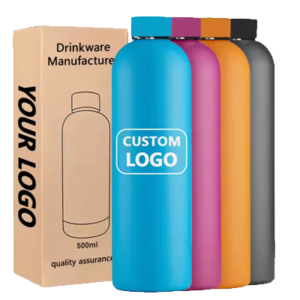How to Choose Plastic Bottle Material for Retailers and Brands?
Let’s face it—plastic water bottles get a bad rap sometimes. But if you’re a retailer or brand trying to meet the ever-changing demands of modern consumers, plastic isn’t the enemy. It’s actually your best friend in disguise (the kind that’s lightweight, durable, and doesn’t shatter into a million pieces when it hits the floor).
Compared to glass or ceramic, plastic bottles are the go-to option for people on the move. They’re lighter than your morning to-do list, easier to toss into a gym bag or a kid’s backpack, and they don’t cry for help when they take a tumble off a desk. That alone makes them a hit with parents, students, commuters, and pretty much anyone with a heartbeat and a schedule.
And let’s talk price. In a world where everything seems to cost more than it did five minutes ago, plastic water bottles are refreshingly affordable. For retailers and brands, that means better margins, faster turnover, and plenty of room to offer stylish designs without needing to sell a kidney.
But the appeal doesn’t stop at price or portability. Thanks to the magic of plastic’s versatility, designers can go wild—from sleek minimalism to playful cartoon characters, from frosted finishes to eye-popping ombré shades. Plastic bottles don’t just hold water—they hold attention.
Even better? They’ve evolved. Add in UV-blocking agents, antibacterial coatings, or double-wall insulation, and you’ve got a bottle that’s not just cute—it’s smart. Whether it’s staying cool in the summer sun, keeping bacteria at bay during a camping trip, or protecting your fingers from the wrath of boiling tea, modern plastic bottles are a far cry from the flimsy freebies of the past.
In short, plastic water bottles aren’t just popular because they’re cheap or cheerful. They’re popular because they work—for a hundred different lifestyles and just as many reasons. Whether your customer is a student, a fitness buff, or a sleep-deprived parent who just needs a leak-proof cup that won’t break the bank, plastic delivers.
Common Plastic Bottle Materials Explained
When it comes to plastic water bottles, not all plastics are created equal. If you’re a retailer or brand trying to figure out what to put on your shelves (or slap your logo on), knowing your materials is half the battle. The other half? Picking the right one to match your customers’ lifestyles, budgets, and—let’s be honest—level of clumsiness.
Table of Contents
Toggle1. PP (Polypropylene): The Workhorse With a Heart of Gold
PP bottles are like the dependable friend who always shows up on time, doesn’t complain, and handles heat like a champ. This material has a smooth, semi-matte finish, usually in solid colors—think simple, practical, and totally unfussy. You won’t get glass-like shine, but you will get microwave safety, BPA-free peace of mind, and a bottle that can handle boiling water without breaking a sweat.
The pros? It’s safe, sturdy, and chemical-resistant. The cons? It might scratch over time, and it’s not winning any beauty contests in the transparency department. But for everyday use—like commuting, office hydration, or giving away as a branded promo item—it gets the job done, and does it well.
Best for: Budget-conscious consumers, corporate giveaways, or anyone who prioritizes practicality over polish.
Cost vibe: Low to mid-range. Great for mass production without mass headaches.
2. Tritan: The Beyoncé of Plastic Bottles
If PP is the reliable friend, Tritan is the one who walks into the room and steals the show. This next-gen plastic looks like glass (without the drama), resists impact better than your Monday mood, and is so safe it’s used in baby bottles. Yep, you read that right—baby bottles.
Tritan is BPA-free, crystal-clear, and handles acidic drinks like juice or soda without turning weird or smelly. It’s dishwasher safe, UV-resistant, and tough enough to survive being launched across the room by a toddler—or dropped by a yoga newbie trying to balance a bottle and a mat.
Best for: Premium product lines, brand gifting, and customers who take “non-toxic” seriously.
Cost vibe: Higher than PP, but your product instantly feels more upscale. A solid investment if you’re aiming for that “Instagrammable and indestructible” combo.
3. Other Players in the Plastic Game
PE (Polyethylene): Think soft, squishy, and wallet-friendly. PE bottles are super lightweight and have great impact resistance, but their low heat tolerance makes them a no-go for hot drinks. Best used for temporary or cold beverage containers. Basically: great for a picnic, not your daily latte.
PC (Polycarbonate): Once the star of gym bottles, now the subject of a PR crisis. PC is strong and clear, but often contains BPA and may degrade with sun exposure, turning yellow over time. Works okay for cold drinks—but hot liquids or UV rays? Not a good combo. These days, it’s mostly been benched in favor of safer options like Tritan.
PS (Polystyrene): Crystal clear, but brittle. Think disposable dessert cups or the freebie bottle that lasts one week before cracking. Not heat-tolerant, not durable—but hey, it’s cheap! Good for giveaways, bad for long-term loyalty.
Want your bottles to say “safe and stylish” instead of “cheap and sketchy”? Then understanding these plastic materials is key. Whether you’re chasing affordability, performance, aesthetics—or the sweet spot where they all meet—choosing the right material sets the stage for everything that follows.
How to Match Material to Market
Picking a plastic bottle material isn’t just about the science—it’s about strategy. Retailers and brands aren’t just selling hydration; they’re selling an experience, a lifestyle, a message. And the type of plastic you choose can make or break the story you’re telling (and your profit margins).
Let’s break it down:
PP: The Budget MVP
If your goal is volume, affordability, and daily practicality, PP is your go-to. It’s widely available, easy to mold, and perfect for bulk production. You won’t get jaw-dropping aesthetics, but you will get a bottle that holds hot tea, survives rough handling, and won’t scare off budget-conscious buyers.
Best for:
- Entry-level products
- Giveaways and promotions
- School, home, and workplace essentials
Cost range:
💰 Low. Great for scaling fast without sacrificing safety.
Tritan: When Looks and Safety Sell
Looking to elevate your product line? Tritan brings premium appeal without requiring luxury pricing. It’s more expensive than PP, yes—but it also gives you sleek transparency, BPA-free bragging rights, and long-term durability that justifies the price. Think of it as the plastic that wears a suit to work and gym shorts on the weekend.
Best for:
- Health-conscious shoppers
- Gifts and mid-to-high-end retail
- Baby and family product lines
Cost range:
💰💰Medium to high. Worth it for higher price points and loyal customers.
PE: The Disposable Hero
Cheap, cheerful, and surprisingly tough—as long as you don’t try to pour boiling water in it. PE is perfect for low-commitment containers: think event giveaways, picnic kits, or anything meant to be used today and forgotten tomorrow.
Best for:
- Temporary storage
- Budget-first, short-term use
- One-off promotional products
Cost range:
💰Very low. But also very limited.
PC: The Fallen Favorite
If you’re still using PC, ask yourself why. Yes, it’s strong and clear, and the upfront cost isn’t bad—but with rising consumer awareness about BPA and health concerns, it’s no longer a great look for your brand. Unless you’re going for retro (and not in a good way), it’s probably time to move on.
Best for:
- Products where regulations are lax (not recommended)
- Cold beverages only
- The clearance bin
Cost range:
💰💰Medium. But brand risk is high.
PS: Pretty but Fragile
Transparent and cheap, PS is good for one thing: looking nice until it cracks. Use it when aesthetics matter more than durability—just don’t expect a second date.
Best for:
- Cold drink cups
- Disposable partyware
- Visual merchandising props
Cost range:
💰Low. Good for appearances, bad for permanence.
So… What’s the Best Choice?
That depends on your audience, your price point, and your product goals. Want to dominate the promo gift space with branded bottles by the thousand? PP is your best friend. Looking to launch a sleek lifestyle line for eco-aware millennials? Tritan’s your hero.
And remember: the “best” plastic isn’t the one with the most features—it’s the one that fits your customer’s needs and your profit margins.
After all, it’s not just about choosing a bottle. It’s about choosing a business model.
Final Sip: Choose Smart, Sell Smarter
Let’s face it—choosing the right plastic material for your water bottles isn’t just a technical task, it’s a strategic move. In crowded market, especially USA, the material you pick says a lot about your brand: PP tells the world you’re practical and price-savvy; Tritan whispers premium quality and chemical-free confidence; PE, PC, and PS each play their own (very specific) roles—if you know where and when to use them.
The key isn’t finding the “best” plastic. It’s about finding the right fit for your customers, your product story, and your business goals. Whether you’re targeting cost-conscious commuters, gym-loving Millennials, or design-hungry gift shoppers, your choice of plastic should support your brand promise—not undermine it.
Still unsure which material is right for your next bestseller? That’s where we come in. As a professional manufacturer of plastic and stainless steel drinkware, we know our way around polymers—and markets. From bulk custom projects to high-end branded tumblers, we help brands and retailers turn material choices into market wins.
Drop us a message to get a quote, request samples, or brainstorm your next custom product. Because great ideas deserve the right material to back them up—and we’re here to help you find it.


